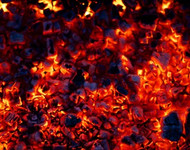How are circular Charcoal Discs for burning incense made?
Posted by Brett Almond
What is charcoal?
Charcoal has been used by humans for millennia. Technically speaking, it’s an impure form of graphitic carbon that is obtained when animal or plant material is partially burned with limited access to air.
The resulting black, brittle fuel has a high burning temperature, meaning it can be used for a range of industrial purposes, including metal smelting. It also serves a variety of domestic and artistic purposes and has even been used in certain medicines.
How is charcoal made?
Most of the world’s charcoal is made using wood, which is heated to high temperatures in an oxygen-poor environment. Without oxygen, the wood can’t actually catch on fire. Instead, it smoulders and everything in the material, apart from the carbon and certain minerals, escapes as a liquid or gas.
The techniques involved in this process have changed relatively little in essence for thousands of years. However, while traditional methods relied on earth or clay burning chambers, modern industrial processes tend to use metal containers. For example, sheet steel kilns are popular, along with steel metal buildings known as retorts. Brick kilns can also be used.
This is the basis of charcoal production. Beyond this, the story gets a little more complicated. The two most popular forms of charcoal now on offer are hardwood lump charcoal and charcoal briquettes or disks. The techniques involved in creating these two distinctive products differ.
How is hardwood lump charcoal formed?
As you might expect, hardwood lump charcoal is simply charcoal made from chunks of hardwood. To make the items, wood is packed tightly together in oxygen-poor containers and burned slowly, without being allowed to flame. The charcoal lumps produced in this way can be uneven in size, as well as in burn time and temperature.
How are small circular charcoal discs formed?
You might be more familiar with small charcoal briquettes or discs. These items are in fact a combination of charcoal and a number of other ingredients that are moulded together into specific shapes. The precise components used vary from product to product, but they can include ingredients such as sawdust and sodium nitrate. These additions are used as binders, to improve ignition and to promote steady burning, as well as to make the manufacturing process more efficient.
Briquettes were initially patented by the American Ellsworth Zwoyer as far back as 1897, but they really started to gain attention in the 1920s when pioneering vehicle manufacturer Henry Ford decided to put the sawdust and scrap wood produced in his factories to good use.
The precise methods involved in creating discs or briquettes differ between companies, but the items are all made using sawdust or wood chips. This material is burned slowly with limited access to oxygen and, once the process is complete, the resulting char is crushed and mixed with the other ingredients. The slurry is then moulded into the desired shapes before being dried.
How come you heat it to make something that will burn again?
At first reckoning, it can seem a little strange that people go to the effort of heating wood to make a product that will burn again. However, there’s a simple reason for this. Pre-burning wood to form charcoal creates a fuel that is much more efficient and reaches higher temperatures than timber. This is because many of steps of combustion have already taken place.
Are there different qualities in charcoal or are all types the same?
Charcoal products may all look fairly similar. They tend to be black and come in small pieces. However, don’t be fooled into thinking that they all have the same properties.
As previously touched on, there’s a big difference between hardwood lumps and the shaped briquettes or discs. For example, briquettes and discs are more consistent in their burn time and temperature because they are all of uniform size and consistency. Also, unlike hardwood lumps, they can be smoke and odour-free.
Another variable to watch out for is the wood used in charcoal products. The fuel can be made from a wide variety of natural materials, but hardwoods such as oak, maple and fruit woods are favoured. This is because they tend to produce a better grade of charcoal.
In addition, you might want to pay attention to the environmental credentials of the charcoal you buy. It’s possible to purchase versions created using sustainably sourced charcoal. For example, the excelsior charcoal tablets we stock are made using discarded cuttings that are collected from sustainable apple orchards. This ensures that no tree is cut down in the process.
How long have people been using charcoal?
There’s something primal about burning charcoal. After all, the first recorded use of the material comes from black pigment found in European cave paintings dating from around 32,000 years ago. However, it’s not known whether this charcoal was made deliberately.
Coming forward in time, it’s thought that people may have been using charcoal as a fuel by approximately 5500BC in the smelting of copper.
How is charcoal used in the burning of incense and resins?
Thanks to its impressive burning qualities, charcoal is perfect for heating incense or resins. If you’re thinking of doing this, rest assured the process is easy.
As well as some charcoal and your fragranced products of choice, all you need are a heatproof container, a source of ignition and possibly some metal tongs. It’s also a good idea to place a little earth in your container for extra heat insulation.
A quick guide
Firstly, light your charcoal using a candle, lighter or match. To protect your hands when you’re doing this, you might want to use metal tongs. If you’re using excelsior charcoal discs, you’ll quickly see sparks emerging from them when the source of heat is applied. This is caused by a special coating that’s added to the products to ensure they light quickly and easily.
Once lit, you can put the tablets into your container. A little patience is then required. Instead of adding your resin immediately, wait for a few minutes until the charcoal has had a chance to heat through. Once you’re satisfied that the disc is at the right temperature, carefully spoon your resin onto it. You can add more as required.
Does charcoal ever give off any harmful gases?
It’s important to be aware that when it is burned, charcoal can give off carbon monoxide. This gas doesn’t smell or taste of anything and you can’t see it. However, it is poisonous.
Because you only need to burn a very small amount of charcoal to release the fragrance of incense, you shouldn’t experience any problems. However, it’s a good idea to ensure that your rooms are well ventilated.
The risk rises when larger quantities of charcoal are burned. For example, barbeques fuelled by charcoal should always be lit outdoors and never used inside enclosed spaces.
Can charcoal ever explode?
Charcoal itself will not explode. If you’ve heard examples of such incidents occurring, it’s likely that some other factor was involved. For instance, there have been cases of people witnessing explosions after setting light to charcoal on concrete. This is because concrete can react to intense heat.
For peace of mind when burning charcoal, always make sure you use suitable heat-resistant containers and follow any instructions provided on the packaging.
© Holisticshop.co.uk. All rights reserved



